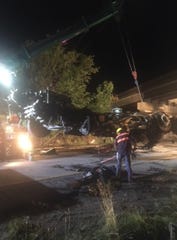The Vigo County coroner's office will use DNA or dental records to try to make an identification, a process which could take several weeks.
September 15, 2018
A semi driver died in a fiery crash, after his truck crashed into the back of another semitrailer truck in heavy traffic Friday evening on I-70.
Emergency agencies responded at 6:51 p.m. to reports of a collision between two semis in the eastbound lane of I-70 at the Darwin Road overpass, according to the Indiana State Police.
Oscar Martinez, 67, of Cypress, Texas, was driving a 2007 Volvo tractor, pulling a box trailer with general freight, when he slowed down as he saw traffic reducing speed in front of him.
Martinez's semi was then struck in the rear by a 2017 Freightliner tractor also pulling general freight. The violent impact caused the Freightliner to erupt in flames, leading to the death of its driver.

A semitrailer truck driver died when his cab erupted in flames when he rear-ended another semi shortly in heavy traffic on I-70 shortly before 7 p.m. on Friday, Sept. 14, 2018. The driver could not immediately be identified. (Photo: Indiana State Police)
According to the State Police, the deceased driver was not identifiable after the crash, even though police believe the driver and truck to be from Ontario, Canada.
The Vigo County coroner's office will use DNA or dental records to try to make an identification, a process which could take several weeks.
Martinez complained of minor pain and was taken to Terre Haute Regional Hospital for treatment, State Police said.
The heavy traffic was believed to be caused by vehicles slowing for a general construction project.
All traffic was rerouted until the lanes could be reopened shortly before 4 a.m. Saturday.


















































